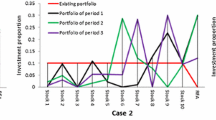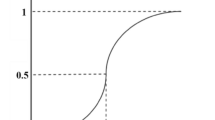Abstract
There are myriad works that deal with the fuzzy multi-period portfolio selection problem, but when we talk about multi-period portfolio selection in an intuitionistic fuzzy realm, to the best of our knowledge, there is no research work that deals with the same. So, to fill this research gap, we propose an intuitionistic fuzzy multi-period portfolio selection model with the objectives of maximization of the terminal wealth and minimization of the cumulative risk subject to several realistic constraints such as complete capital utilization, no short selling, fixed transaction costs for buying and selling, bounds on the desired returns of each period, cardinality constraint, and bounds on the minimal and the maximal proportion of the capital allocated to an asset. The membership and non-membership of the objectives are modeled using their extreme values. The proposed approach provides avenues for the inclusion and minimization of the hesitation degree into decision making, thereby resulting in a significantly better portfolio. Parameters \(\theta _W\) and \(\theta _{Va}\) are used to introduce the hesitation in the model, and, based on their values, the model is further categorized into optimistic and pessimistic intuitionistic fuzzy multi-period portfolio selection models for optimistic and pessimistic investors, respectively. The max–min approach is used to solve the proposed models. Furthermore, a numerical illustration is presented to exhibit the virtues of the proposed model.






Similar content being viewed by others
References
Arqub OA (2017) Adaptation of reproducing kernel algorithm for solving fuzzy Fredholm–Volterra integrodifferential equations. Neural Comput Appl 28(7):1591–1610
Arqub OA, Abo-Hammour Z (2014) Numerical solution of systems of second-order boundary value problems using continuous genetic algorithm. Inf Sci 279:396–415
Arqub OA, Mohammed AS, Momani S, Hayat T (2016) Numerical solutions of fuzzy differential equations using reproducing kernel Hilbert space method. Soft Comput 20(8):3283–3302
Arqub OA, Al-Smadi M, Momani S, Hayat T (2017) Application of reproducing kernel algorithm for solving second-order, two-point fuzzy boundary value problems. Soft Comput 21(23):7191–7206
Atanassov KT (1986) Intuitionistic fuzzy sets. Fuzzy Sets Syst 20(1):87–96
Atanassov K, Gargov G (1989) Interval valued intuitionistic fuzzy sets. Fuzzy Sets Syst 31(3):343–349
Bellman R, Zadeh LA (1970) Decision making in a fuzzy environment. Manag Sci 17B:141–164
Carlsson C, Fullér R (2001) On possibilistic mean value and variance of fuzzy numbers. Fuzzy Sets Syst 122(2):315–326
Chang TJ, Meade N, Beasley JE, Sharaiha YM (2000) Heuristics for cardinality constrained portfolio optimisation. Comput Oper Res 27(13):1271–1302
Chen G, Luo Z, Liao X, Yu X, Yang L (2011) Mean–variance–skewness fuzzy portfolio selection model based on intuitionistic fuzzy optimization. Procedia Eng 15:2062–2066
Chen W, Li D, Lu S, Liu W (2019) Multi-period mean-semivariance portfolio optimization based on uncertain measure. Soft Comput 23(15):6231–6247
Deng X, Pan X (2018) The research and comparison of multi-objective portfolio based on intuitionistic fuzzy optimization. Comput Ind Eng 124:411–421
Fang Y, Lai KK, Wang SY (2006) Portfolio rebalancing model with transaction costs based on fuzzy decision theory. Eur J Oper Res 175:879–893
Guo S, Yu L, Li X, Kar S (2016) Fuzzy multi-period portfolio selection with different investment horizons. Eur J Oper Res 254(3):1026–1035
Gupta P, Mehlawat MK, Saxena A (2008) Asset portfolio optimization using fuzzy mathematical programming. Inf Sci 178:1734–1755
Gupta P, Mittal G, Mehlawat MK (2013) Expected value multiobjective portfolio rebalancing model with fuzzy parameters. Insur Math Econ 52(2):190–203
Gupta P, Mehlawat MK, Inuiguchi M, Chandra S (2014) Fuzzy portfolio optimization: advances in hybrid multi-criteria methodologies. Springer, Heidelberg
Kar MB, Kar S, Guo S, Li X, Majumder S (2019) A new bi-objective fuzzy portfolio selection model and its solution through evolutionary algorithms. Soft Comput 23(12):4367–4381
Katagiri H, Ishii H (1999) Fuzzy portfolio selection problem. In: IEEE SMC’99 Conference Proceedings, vol 3, pp 973–978
Kocadağlı O, Keskin R (2015) A novel portfolio selection model based on fuzzy goal programming with different importance and priorities. Expert Syst Appl 42(20):6898–6912
Li T, Zhang W, Xu W (2015) A fuzzy portfolio selection model with background risk. Appl Math Comput 256:505–513
Liagkouras K, Metaxiotis K (2018) Multi-period mean-variance fuzzy portfolio optimization model with transaction costs. Eng Appl Artif Intell 67:260–269
Liu YJ, Zhang WG (2015) A multi-period fuzzy portfolio optimization model with minimum transaction lots. Eur J Oper Res 242(3):933–941
Liu YJ, Zhang WG, Xu WJ (2012) Fuzzy multi-period portfolio selection optimization models using multiple criteria. Automatica 48(12):3042–3053
Liu YJ, Zhang WG, Zhao XJ (2018) Fuzzy multi-period portfolio selection model with discounted transaction costs. Soft Comput 22(1):177–193
Markowitz H (1952) Portfolio selection. J Finance 7(1):77–91
Mehlawat MK (2016) Credibilistic mean-entropy models for multi-period portfolio selection with multi-choice aspiration levels. Inf Sci 345:9–26
Mehlawat MK, Gupta P (2014) Fuzzy chance-constrained multiobjective portfolio selection model. IEEE Trans Fuzzy Syst 22(3):653–671
Mehlawat MK, Kumar A, Yadav S, Chen W (2018) Data envelopment analysis based fuzzy multi-objective portfolio selection model involving higher moments. Inf Sci 460–461:128–150
Parra MA, Terol AB, Rodriguez MV (2001) A fuzzy goal programming approach to portfolio selection. Eur J Oper Res 133:287–297
Sadjadi SJ, Seyedhosseini SM, Hassanlou K (2011) Fuzzy multi period portfolio selection with different rates for borrowing and lending. Appl Soft Comput 11(4):3821–3826
Soleimani H, Golmakani HR, Salimi MH (2009) Markowitz-based portfolio selection with minimum transaction lots, cardinality constraints and regarding sector capitalization using genetic algorithm. Expert Syst Appl 36(3):5058–5063
Wang B, Li Y, Watada J (2017) Multi-period portfolio selection with dynamic risk/expected-return level under fuzzy random uncertainty. Inf Sci 385:1–18
Yue W, Wang Y, Xuan H (2019) Fuzzy multi-objective portfolio model based on semi-variance-semi-absolute deviation risk measures. Soft Comput 23(17):8159–8179
Zadeh LA (1965) Fuzzy sets. Inf Control 8:338–353
Zhang P (2019) Multiperiod mean absolute deviation uncertain portfolio selection with real constraints. Soft Comput 23(13):5081–5098
Zhang WG, Liu YJ, Xu WJ (2012) A possibilistic mean-semivariance-entropy model for multi-period portfolio selection with transaction costs. Eur J Oper Res 222(2):341–349
Zimmermann HJ (1978) Fuzzy programming and linear programming with multiple objective functions. Fuzzy Sets Syst 1:45–55
Acknowledgements
We thank the Editor-in-Chief, the Managing Editor, and all the esteemed reviewers for helping us improve the presentation of the paper. The third author, Sanjay Yadav, is supported by the National Fellowship for Other Backward Classes (OBC) granted by University Grants Commission (UGC), New Delhi, India, vide Letter No. F./2016-17/NFO-2015-17-OBC-DEL-34358/(SA-III/Website). The fourth author, Arun Kumar, is supported by the Rajiv Gandhi National Fellowship for SC Candidates granted by University Grants Commission (UGC), New Delhi, India, vide Letter No. F1-17.1/2015-16/RGNF-2015-17-SC-DEL-8966/(SA-III/Website).
Author information
Authors and Affiliations
Corresponding author
Ethics declarations
Conflict of interest
The authors declare that they have no conflict of interest.
Additional information
Communicated by V. Loia.
Publisher's Note
Springer Nature remains neutral with regard to jurisdictional claims in published maps and institutional affiliations.
Rights and permissions
About this article
Cite this article
Gupta, P., Mehlawat, M.K., Yadav, S. et al. Intuitionistic fuzzy optimistic and pessimistic multi-period portfolio optimization models. Soft Comput 24, 11931–11956 (2020). https://doi.org/10.1007/s00500-019-04639-3
Published:
Issue Date:
DOI: https://doi.org/10.1007/s00500-019-04639-3




